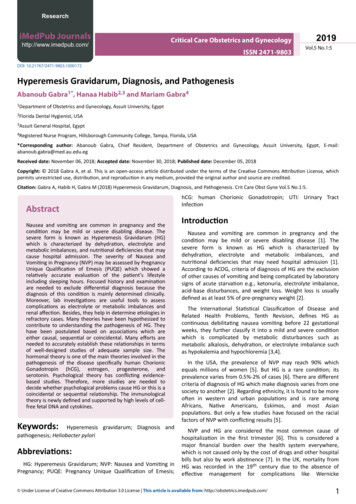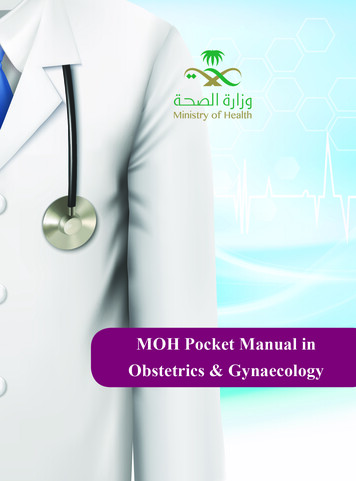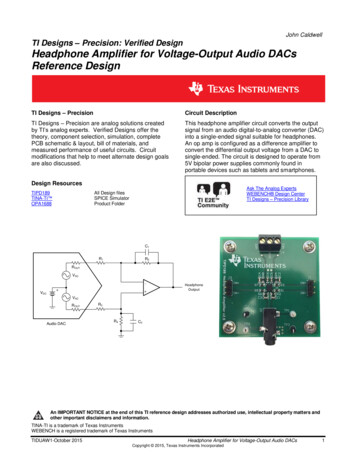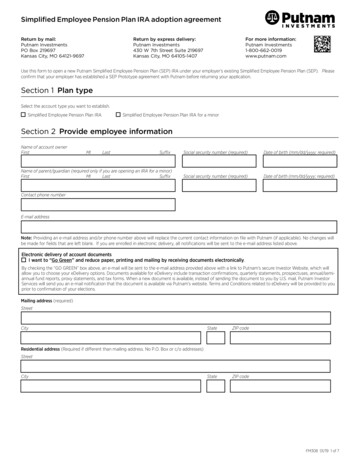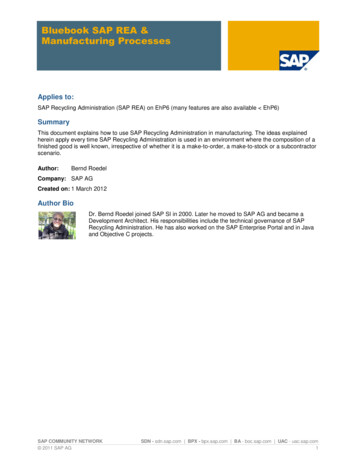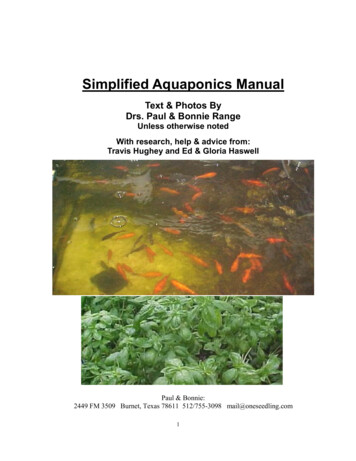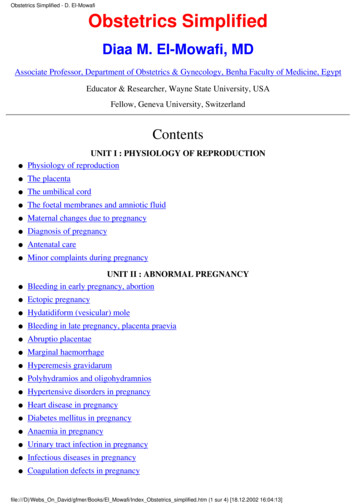
Transcription
Obstetrics Simplified - D. El-MowafiObstetrics SimplifiedDiaa M. EI-Mowafi, MDAssociate Professor, Department of Obstetrics & Gynecology, Benha Faculty of Medicine, EgyptEducator & Researcher, Wayne State University, USAFellow, Geneva University, SwitzerlandContents UNIT I : PHYSIOLOGY OF REPRODUCTIONPhysiology of reproduction The placenta The umbilical cord The foetal membranes and amniotic fluid Maternal changes due to pregnancy Diagnosis of pregnancy Antenatal care Minor complaints during pregnancy UNIT II : ABNORMAL PREGNANCYBleeding in early pregnancy, abortion Ectopic pregnancy Hydatidiform (vesicular) mole Bleeding in late pregnancy, placenta praevia Abruptio placentae Marginal haemorrhage Hyperemesis gravidarum Polyhydramios and oligohydramnios Hypertensive disorders in pregnancy Heart disease in pregnancy Diabetes mellitus in pregnancy Anaemia in pregnancy Urinary tract infection in pregnancy Infectious diseases in pregnancy Coagulation defects in pregnancyfile:///D /Webs On David/gfmer/Books/El Mowafi/Index Obstetrics simplified.htm (1 sur 4) [18.12.2002 16:04:13]
Obstetrics Simplified - D. El-Mowafi Jaundice in pregnancy Thyrotoxicosis and epilepsy in pregnancy. Iso-immunization in pregnancy Abdominal pain with pregnancy Retroverted gravid uterus, pendulous abdomen Gynaecologic tumours with pregnancy High risk pregnancy Post-term pregnancy Preterm labour Premature rupture of membranes Tocolytic drugs UNIT III : NORMAL LABOURAnatomy of the female pelvis Anatomy of the foetal skull Obstetric terms Normal labour Active management of labour UNIT IV : ABNORMAL LABOURMalposition and malpresentations Occipito-posterior position Face presentation Brow presentation Compound presentation Breech presentation Shoulder presentation (transverse or oblique lie) Cord presentation and prolapse Multiple pregnancy Abnormal uterine action Prolonged labour Obstructed labour Contracted pelvis Dystocia due to oversized foetus Maternal obstetric injuries Complications of the third stage of labour: Postpartum haemorrhage Retained placenta Acute inversion of the uterusfile:///D /Webs On David/gfmer/Books/El Mowafi/Index Obstetrics simplified.htm (2 sur 4) [18.12.2002 16:04:13]
Obstetrics Simplified - D. El-Mowafi Shock in obstetrics Haemorrhagic shock Endotoxic shock Amniotic fluid embolism Cardiac arrestUNIT V : THE PUERPERIUM The puerperium Puerperal sepsis Breast disorders in the puerperiumUNIT VI : THE FOETUS The foetal physiology Assessment of foetal maturity and wellbeing Intrauterine growth retardation Placental insufficiency Perinatal mortality Foetal asphyxia Congenital anomalies Foetal birth traumaUNIT VII : MISCELLANEOUS The relief of pain in labour Ecbolics (uterine stimulants) Maternal mortality Induction of labour Ultrasonography in obstetrics Radiology in obstetricsUNIT VIII : OBSTETRIC DIAGNOSIS Obstetric diagnosisUNIT IX : OPERATIVE OBSTETRICS Forceps delivery Vacuum extraction (ventouse) Caesarean section Version Episiotomy Symphysiotomy Destructive operationsfile:///D /Webs On David/gfmer/Books/El Mowafi/Index Obstetrics simplified.htm (3 sur 4) [18.12.2002 16:04:13]
Obstetrics Simplified - D. El-MowafiBibliographyNational Library Card No. 1996/8705I.S.B.N. 977-19-1357-3First edition 1997All rights are reserved to the author. No part of this book may be reproduced or transmitted in anyform without prior written permission of him.Published by the author: Burg Abu-Samra ,El-Happy Land Square, El-Mansoura ,Egypt. Tel.(050)363308 Tel.(013) 223449. Fax. (050) 33277128.11.02Pagestrouvéesdepuis 28.8.2001file:///D /Webs On David/gfmer/Books/El Mowafi/Index Obstetrics simplified.htm (4 sur 4) [18.12.2002 16:04:13]
Department of Obstetrics and Gynecology, Benha Faculty of Medicine, Zagagig University, EgyptDEPARTMENT OF OBSTETRICS AND GYNECOLOGYBENHA FACULTY OF MEDICINEZAGAZIG UNIVERSITY, EGYPTCoordinatorDiaa M. El-Mowafi, MDAssociate Professor, Obstetrics and Gynecology DepartmentBenha Faculty of MedicineLecturer & Researcher, Wayne State University, USAFellow, Geneva University, Switzerland4 Ghazza Street, El-Hossania, El-Mansoura 35111, EgyptTel. 2 050 363308Fax 2 050 332771Chairman : Prof. Hazim IsmailDepartment started in 1978. It has 48 beds. Divided into 4 units, each is supervised by a professor.The department has the following specialized units: Endoscopic Surgery. Ultrasonography. Colposcopy. Cytology. Fetal monitoring.file:///D /Webs On David/gfmer/Books/El Mowafi/Department.htm (1 sur 3) [18.12.2002 16:04:27]
Department of Obstetrics and Gynecology, Benha Faculty of Medicine, Zagagig University, Egypt Assisted reproductive techniques ( in development).There are 4 operative lists every week. Emergency cases are around 15-30 cases / day. Thedepartment has its annual international congress.It organizes bi-annual training courses in: diagnostic and operative laparoscopy and hysterescopy, basic and advanced ultrasonography, colposcopy, cytology, fetal monitoring.The degrees that are given by the department are : Diploma in Obstetrics and Gynecology. Master degree (M.Sc.) in Obstetrics and Gynecology. Medical doctorate (M.D.) in Obstetrics and Gynecology.Book Obstetrics Simplified - D. El-MowafiScientific papers Chlamydia trachomatis in women with intermenstrual bleeding using different methods ofcontraception - D. El-Mowafi, U. El-Hendy Dilapan versus Prostaglandin E1 in Induction of Midtrimester Abortion - D. El-Mowafi, N.El-Orabi, I. El-Arousi Fallopian Tube - D. El-Mowafi, M.P. Diamond Gynecologic surgery and subsequent bowel obstruction - D. El-Mowafi, M.P. Diamond Laparoscopically Assisted Vaginal Hysterectomy: A Gimmick or An Advance? - D.El-Mowafi, Ch. Lall Maternal and Umbilical Cord Plasma Renin Activity in Pregnancy Induced Hypertension - S.Saad, M. Abd El-Hadi, D. El-Mowafi, F. El-Shenawy, A. El-Metwally Pelvic Adhesions - D. El-Mowafi, M.P. Diamond Peritoneal fluid embryotoxicity and cytokine (TNF-alpha ) level in endometriosis associatedinfertility - D. El-Mowafi, W. El-Mosallamy, E. Basiony, S. Ghany, R. Arafa, U. El-Hendy Peritoneal fluid mediated embryotoxicity in unexplained infertility - D. El-Mowafi, U.El-Hendy, R. Arafa, W. El-Mosallamy, E. Basiony, E. Ghany Placental Localization by Transperineal Sonography in Antepartum Hemorrhage - D.El-Mowafi, A.-F. Hegazi Transvaginal Sonography and Hysteroscopy Versus Histopathology in Postmenopausalfile:///D /Webs On David/gfmer/Books/El Mowafi/Department.htm (2 sur 3) [18.12.2002 16:04:27]
Department of Obstetrics and Gynecology, Benha Faculty of Medicine, Zagagig University, EgyptBleeding - D. El-Mowafi, A. Farid, A. El-Badawi Ultrasonographic Versus Laparoscopic Control of Hysteroscopic Surgery - D. El-Mowafi Vaginal Dopamine Agonists: Biochemical and Clinical Responses - A New Trial - D.El-Mowafi, M. Youssef, M.A. Hassan03.12.02file:///D /Webs On David/gfmer/Books/El Mowafi/Department.htm (3 sur 3) [18.12.2002 16:04:27]
Physiology of Reproduction - D. El-MowafiObstetrics SimplifiedDiaa M. EI-Mowafi, MDAssociate Professor, Department of Obstetrics & Gynecology, Benha Faculty of Medicine, EgyptPhysiology of ReproductionPregnancy occurs when a mature liberated ovum is fertilized by a mature capacitated spermatozoon.The Sperm: The spermatozoa leave the testis carrying 23 chromosomes but not yet capable offertilization. Their maturation is completed through their journey in the 6 meters of theepididymis and when mixed with the seminal plasma from the epididymis, seminalvesicle and prostate gland. After semen is ejaculated, the sperms reach the cervix by their own motility withinseconds leaving behind the seminal plasma in the vagina. At time of ovulation, the cervical mucous is in the most favourable condition forsperm penetration and capacitation as:- It becomes more copious, less viscous and its macromoleculesarrange in parallel chains providing channels for spermspassage.- Its contents from glucose and chloride are increased. The sperms ascent through the uterine cavity and Fallopian tubes to reach the siteof fertilization in the ampulla by:1. its own motility,2. uterine and tubal peristalsis which is aggravated by the prostaglandinsin the seminal plasma. The sperms reach the tube within 30-40 minutes but they are capable offertilization after 2-6 hours. This period is needed for sperm capacitation. Capacitation of sperms is the process after which the sperm becomes able topenetrate the zona pellucida,that surrounding the ovum and fertilize it. The cervicaland tubal secretions are mainly responsible for this capacitation. Capacitation isbelieved to be due to :a. increase in the DNA concentration in the nucleus,b. increase permeability of the coat of sperm head to allow more release ofhyaluronidase.The ovum:file:///D /Webs On David/gfmer/Books/El Mowafi/Physiology of reproduction.htm (1 sur 4) [18.12.2002 16:04:28]
Physiology of Reproduction - D. El-Mowafi The ovum leaves the the ovary after rupture of the Graafian follicle, carrying 23chromosomes and surrounded by the zona pellucida and corona radiata. The ovum is picked up by the fimbriated end of the Fallopian tubes and movedtowards the ampulla by the ciliary movement of the cells and rhythmic peristalsisof the tube.Fertilization: Millions of sperms ejaculated in the vagina, but only hundreds of thousands reachthe outer portion of the tubes. Only few succeed to penetrate the zona pellucida,and only one spermatozoon enters the ovum transversing the perivitelline space. After penetration of the ovum by a sperm, the zona pellucida resists penetration byanother sperms due to alteration of its electrical potential. The pronucleus of both ovum and sperm unite together to form the zygote (46chromosomes).Sex Determination:The mature ovum carries 22 autosomes and one X chromosome, while the mature sperm carries 22autosomes and either an X or Y chromosome. If the fertilizing sperm is carrying X chromosome thebaby will be a female (46 XX), if it is carrying Y chromosome the baby will be a male (46 XY).Cleavage and blastocyst formation: On its way to the uterine cavity, the fertilized ovum (zygote) divides into 2,4,8then 16 cells (blastomeres). This division (cleavage) starts within 24 hours offertilization and occurs nearly every 12 hours repeatedly the resultant 16 cells massis called morula which reaches the uterine cavity after about 4 days fromfertilization. A cavity appears within the morula converting it into a cystic structure calledblastocyst. In which the cells become arranged into an inner mass (embryoblast)which will form all the tissues of the embryo, and an outer layer called trophoblastwhich invade the uterine wall. The blastocyst remains free in the uterine cavity for 3-4 days, during which it isnourished by the secretion of the endometrium (uterine milk).Implantation (nidation) :The decidua:It is the thickened vascular endometrium of the pregnant uterus. It is called so because it casts of afterparturition. The glands become enlarged, tortuous and filled with secretion. The stroma cells becomelarge with small nuclei and clear cytoplasm, these are called decidual cells.The decidua, like secretory endometrium, consists of three layers:- the superficial compact layer,file:///D /Webs On David/gfmer/Books/El Mowafi/Physiology of reproduction.htm (2 sur 4) [18.12.2002 16:04:28]
Physiology of Reproduction - D. El-Mowafi- the intermediate spongy layer,- the thin basal layer.The separation of placenta occurs through the spongy layer while the endometrium regenerates againfrom the basal layer. The trophoblast of the blastocyst invades the decidua to be implanted in:- the posterior surface of the upper uterine segment in about 2/3of cases,- the anterior surface of the upper uterine segment in about 1/3of cases. After implantation the decidua becomes differentiated into:- decidua basalis; under the site of implantation.- decidua capsularis; covering the ovum.- decidua parietalis or vera; lining the rest of the uterine cavity.As the conceptus enlarges and fills the uterine cavity the decidua capsularis fuses with the deciduaparietalis. This occurs nearly at the end of 12 weeks.The decidua has the following functions:1. It is the site of implantation.2. It resists more invasion of the trophoblast.3. It nourishes the early implanted ovum by its glycogen and lipidcontents.4. It shares in the formation of the placenta.Chorion: After implantation, the trophoblast differentiates into 2 layers:a. an outer one called syncytium (syncytiotrophoblast) which ismultinucleated cells without cell boundaries,b. an inner one called Langhan’s layer (Cytotrophoblast) whichis cuboidal cells with simple cytoplasm.A third layer of mesoderm appears inner to the cytotrophoblast. The trophoblast and the lining mesoderm together form the chorion. Mesodermal tissue ( connecting stalk) connects the inner cell mass to the chorionand will form the umbilical cord later on. Spaces (lacunae) appear in the syncytium, increase in size and fuse together toform the " chorio-decidual space" or " intervillus space". Erosion of the decidualblood vessels by the trophoblast allows blood to circulate in this space.file:///D /Webs On David/gfmer/Books/El Mowafi/Physiology of reproduction.htm (3 sur 4) [18.12.2002 16:04:28]
Physiology of Reproduction - D. El-Mowafi The outer syncytium and inner Langhan’s cells form buds surrounding thedeveloping ovum called primary villi.When the mesoderm invades the center of the primary villi they are called secondaryvilli. When blood vessels (branches from the umbilical vessels) develop inside themesodermal core, they are called tertiary villi. At first, the chorionic villi surround the developing ovum. After the 12th week, thevilli opposite the decidua capsularis atrophy leaving the chorion laeve which formsthe outer layer of the foetal membrane and is attached to the margin of theplacenta. The villi opposite the decidua basalis grow and branch to form thechorion frondosum and together with the decidua basalis will form the placenta.Some of these villi attach to the decidua basalis ( the basal plate) called the"anchoring villi", other hang freely in the intervillous spaces called "absorbingvilli" After implantation, 2 cavities appear in the inner cell mass; the amniotic cavity andyolk sac and inbetween these 2 cavities the mesoderm develops. The layer of cells at the floor of the amniotic cavity will give the ectodermalstructures of the foetus and the layer of cells at the roof of the yolk sac will givethe endodermal structures of the foetus and the mesoderm inbetween will give themesodermal structure.Amnion:Phases of conceptus development:1. The ovum: the products of conception in the first 2 weeks after fertilization.2. The embryo: from 3 to 5 weeks.3. The foetus: the developing infant (6-40 wks).18.11.02file:///D /Webs On David/gfmer/Books/El Mowafi/Physiology of reproduction.htm (4 sur 4) [18.12.2002 16:04:28]
The Placenta - D. El-MowafiObstetrics SimplifiedDiaa M. EI-Mowafi, MDAssociate Professor, Department of Obstetrics & Gynecology, Benha Faculty of Medicine, EgyptThe PlacentaOrigin:The placenta develops from the chorion frondosum ( foetal origin) and decidua basalis ( maternalorigin).Anatomy At Term:Shape: discoid. Diameter : 15-20 cm. Weight : 500 gm.Thickness: 2.5 cm at its center and gradually tapers towards the periphery.Position : in the upper uterine segment (99.5%), either in the posterior surface (2/3) orthe anterior surface (1/3).Surfaces:a. Foetal surface: smooth, glistening and is covered by the amnion which is reflected onthe cord. The umbilical cord is inserted near or at the center of this surface and itsradiating branches can be seen beneath the amnion.b. Maternal surface: dull greyish red in colour and is divided into 15-20 cotyledons. Eachcotyledon is formed of the branches of one main villus stem covered by decidua basalis.Functions Of The Placenta:(1) Respiratory function:O2 and CO2 pass across the placenta by simple diffusion. The foetal haemoglobin has more affinityand carrying capacity than adult haemoglobin. 2,3 diphosphoglycerate (2,3-DPG) which competes foroxygen binding sites in the haemoglobin molecule, is less bounded to the foetal haemoglobin (HbF)and thereby allows a greater uptake of O2 ( O2 affinity). The rate of diffusion depends upon:a. maternal/ foetal gases gradient.b. maternal and foetal placental blood flow.c. placental permeability.d. placental surface area.(2) Nutritive function:The transfer of nutrients from the mother to the foetus is achieved by :file:///D /Webs On David/gfmer/Books/El Mowafi/Placenta.htm (1 sur 5) [18.12.2002 16:04:28]
The Placenta - D. El-Mowafi- Simple diffusion : e.g. water and electrolytes.- Facilitated diffusion: e.g. glucose.- Active diffusion: e.g. aminoacids.- Pinocytosis: e.g. large protein molecules and cells.(3) Excretory function:Waste products of the foetus as urea are passed to maternal blood by simple diffusion through theplacenta.(4) Production of enzymes:e.g. oxytocinase, monoamino oxidase, insulinase, histaminase and heat stable alkaline phosphatase.(5) Production of pregnancy associated plasma proteins (PAPP):e.g. PAPP-A, PAPP-B, PAPP-C, PAPP-D and PP5. The exact function of these proteins is notdefined.(6) Barrier function:The foetal blood in the chorionic villi is separated from the maternal blood, in the intervillous spaces,by the placental barrier which is composed of :(i) endothelium of the foetal blood vessels,(ii) the villous stroma,(iii) the cytotrophoblast, and(iv) the syncytiotrophoblast.However, it is an incomplete barrier. It allows the passage of antibodies (IgG only), hormones,antibiotics, sedatives, some viruses as rubella and smallpox and some organisms as treponema pallida.Substances of large molecular size as heparin and insulin cannot pass the placental barrier.(7) Endocrine function:(A) Protein hormones:1- Human chorionic gonadotrophin (hCG):- It is a glycoprotein produced by the syncytiotrophoblast.- It supports the corpus luteum in the first 10 weeks of pregnancy to produceoestrogen and progesterone until the syncytiotrophoblast can produceprogesterone.- HCG molecule is composed of 2 subunits:a. alpha subunit which is similar to that of FSH, LH and TSH.b. beta subunit which is specific to hCG.- HCG rises sharply after implantation, reaches a peak of 100.000 mIU/mlfile:///D /Webs On David/gfmer/Books/El Mowafi/Placenta.htm (2 sur 5) [18.12.2002 16:04:28]
The Placenta - D. El-Mowafiabout the 60th day of pregnancy then falls sharply by the day 100 to 30.000mIU/ml and is maintained at this level until term.- Estimation of beta-hCG is used for:a) diagnosis of early pregnancy.b) diagnosis of ectopic pregnancy.c) diagnosis and flow-up of trophoblastic disease.2- Human placental lactogen (hPL):- It is a ploypeptide hormone produced by the syncytiotrophoblast.- The supposed actions of hPL include:a. lipolysis: increasing free fatty acids which provide a sourceof energy for mother and foetal nutrition.b. inhibition of gluconeogenesis: thus spare both glucose andprotein explaining the anti-insulin effect of hPL.c. somatotrophic : i.e. growth promotion of the foetus due toincreased supply of fatty acids, glucose and amino acids.d. mammotropic and lactogenic effect.- HPL can be detected by the 5-6th week of pregnancy, rises steadily untilthe 36th week to be 6m g/ml.- Its level is proportional to the placental mass.3- Human chorionic thyrotrophin (hCT):No significant role has been established for it, but it is probably responsible for increased maternalthyroid activity and promotion of foetal thyroid development.4- Hypothalamic and pituitary like hormones:e.g. gonadotropin releasing hormone (GnRH) ,corticotropin releasing factor (CRF), ACTH andmelanocyte stimulating hormone.5- Others as inhibin, relaxin and beta endorphins.(B) Steroid Hormones:1- Oestrogens:- They are synthetized by syncytiotrophoblast from their precursorsdehydroepiandrosterone sulphate (DHES) or its 16a -hydroxy (16a - OH- DHES).- Near term, 50% of DHES is drived from the foetal adrenal gland and 50% frommaternal adrenal. It is transformed in the placenta into oestradiol- 17b (E2).- On the other hand , 90% of 16a - OH - DHES is drived from foetal origin afterhydroxylation of DHES in the foetal liver, while only 10% is drived from the mother byfile:///D /Webs On David/gfmer/Books/El Mowafi/Placenta.htm (3 sur 5) [18.12.2002 16:04:28]
The Placenta - D. El-Mowafithe same way.- Oestrogens are excreted in the maternal urine as oestriol (E3), oestradiol (E2) andoestrone (E1). Oestriol (E3) is the largest portion of them.- Maternal urinary and serum oestriol level is an important index for foetal wellbeing asits synthesis depends mainly on the integrity of the foetal adrenal and liver as well as theplacenta (foeto- placental unit).- Urinary oestriol increases as pregnancy advances to reach 35-40 mg per 24 hours at fullterm. Progressive fall in urinary oestriol indicates that the foetus is jeopardous.- Oestrogens are responsible with progesterone for the most of the maternal changes dueto pregnancy especially that in genital tract and breasts.2- Progesterone:- It is synthetized by syncytiotrophoblast from the maternal cholesterol.- Excreted in maternal urine as pregnandiol.- Increasing gradually during pregnancy to reach a daily production of 250 mg per day inlate normal single pregnancy.- It provides a precursor for the foetal adrenal to produce glucocorticoids andmineralocorticoids.Abnormalities Of The Placenta(A) Abnormal Shape:1. Placenta Bilobata: The placenta consists of two equal lobes connected byplacental tissue.2. Placenta Bipartita: The placenta consists of two equal parts connected bymembranes. The umbilical cord is inserted in one lobe and branches from itsvessels cross the membranes to the other lobe. Rarely, the umbilical cord dividesinto two branches, each supplies a lobe.3. Placenta Succenturiata: The placenta consists of a large lobe and a smaller oneconnecting together by membranes. The umbilical cord is inserted into the largelobe and branches of its vessels cross the membranes to the small succenturiate(accessory) lobe. The accessory lobe may be retained in the uterus after deliveryleading to postpartum haemorrhage. This is suspected if a circular gap is detectedin the membranes from which blood vessels pass towards the edge of the mainplacenta.4. Placenta Circumvallata: A whitish ring composed of decidua, is seen around theplacenta from its foetal surface. This may result when the chorion frondosum istwo small for the nutrition of the foetus, so the peripheral villi grow in such a waysplitting the decidua basalis into a superficial layer ( the whitish ring) and a deeplayer. It can be a cause of abortion, antepartum haemorrhage, premature labour andfile:///D /Webs On David/gfmer/Books/El Mowafi/Placenta.htm (4 sur 5) [18.12.2002 16:04:28]
The Placenta - D. El-Mowafiintrauterine foetal death.5. Placenta Fenestrata: A gap is seen in the placenta covered by membranes givingthe appearance of a window.(B) Abnormal Diameter:Placenta membranacea: A great part of the chorion develops into placental tissue. The placenta islarge, thin and may measure 30-40 cm in diameter. It may encroach on the lower uterine segment i.e.placenta praevia.(C) Abnormal Weight:The placenta increases in size and weight as in congenital syphilis, hydrops foetalis and diabetesmellitus.(D) Abnormal Position:Placenta Praevia: The placenta is partly or completely attached to the lower uterine segment.(E) Abnormal Adhesion:Placenta Accreta: The chorionic villi penetrate deeply into the uterine wall to reach the myometrium,due to deficient decidua basalis. When the villi penetrate deeply into the myometrium, it is called"placenta increta" and when they reach the peritoneal coat it is called "placenta percreta".(F) Placental Lesions:1- Placental Infarcts:Seen in placenta at term, mainly in hypertensive states with pregnancy.a. White infracts: due to excessive fibrin deposition. Normal placenta may contain whiteinfracts in which calcium deposition may occur.b. Red infarcts : due to haemorrhage from the maternal vessels of the decidua. Old redinfarcts finally become white due to fibrin deposition.2- Placental Tumour:Chorioangioma is a rare benign tumour of the placental blood vessels which may be associated withhydramnios.18.11.02file:///D /Webs On David/gfmer/Books/El Mowafi/Placenta.htm (5 sur 5) [18.12.2002 16:04:28]
The Umbilical Cord - D. El-MowafiObstetrics SimplifiedDiaa M. EI-Mowafi, MDAssociate Professor, Department of Obstetrics & Gynecology, Benha Faculty of Medicine, EgyptThe Umbilical CordAnatomyOrigin : It develops from the connecting stalk.Length: At term, it measures about 50 cm.Diameter: 2 cm.Structure: It consists of mesodermal connective tissue called Wharton's jelly, coveredby amnion. It contains:- one umbilical vein carries oxygenated blood from the placentato the foetus,- two umbilical arteries carry deoxygenated blood from thefoetus to the placenta,- remnants of the yolk sac and allantois.Insertion: The cord is inserted in the foetal surface of the placenta near the center "eccentric insertion" (70%) or at the center "central insertion" (30%).Abnormalities Of The Umbilical Cord(A) Abnormal cord insertion:1. Marginal insertion : in the placenta ( battledore insertion).2. Velamentous insertion: in the membranes and vessels connect the cord tothe edge of the placenta. If these vessels pass at the region of the internal os ,the condition is called " vasa praevia". Vasa praevia can occur also when thevessels connecting a succenturiate lobe with the main placenta pass at theregion of the internal os.(B) Abnormal cord length:1. Short cord which may lead to :i- intrapartum haemorrhage due to premature separation of the placenta,ii- delayed descent of the foetus druing labour,iii- inversion of the uterus.file:///D /Webs On David/gfmer/Books/El Mowafi/Umbilical cord.htm (1 sur 2) [18.12.2002 16:04:28]
The Umbilical Cord - D. El-Mowafi2. Long cord which may lead to:i- cord presentation and cord prolapse,ii- coiling of the cord around the neck,iii- true knots of the cord.(C) Knots of the cord:1. True knot: when the foetus passes through a loop of the cord. If pulledtight, foetal asphyxia may result.2. False knot: localised collection of Wharton’s jelly containing a loop ofumbilical vessels.(D) Torsion of the cord:may occur particularly in the portion near the foetus where the Wharton's jelly is less abundant.(E) Haematoma :Due to rupture of one of the umbilical vessels.(F) Single umbilical artery :may be associated with other foetal congenital anomalies.18.11.02file:///D /Webs On David/gfmer/Books/El Mowafi/Umbilical cord.htm (2 sur 2) [18.12.2002 16:04:28]
The Foetal Membranes - D. El-MowafiObstetrics SimplifiedDiaa M. EI-Mowafi, MDAssociate Professor, Department of Obstetrics & Gynecology, Benha Faculty of Medicine, EgyptThe Foetal Membranes(1) The chorion: is the outer membrane. It is in contact with the uterine wall. It is attached to themargins of the placenta.Histologically, it is composed of 4 layers:i) Cellular layerii) dense reticulumiii) pseudo - basement membraneiv) outer trophoblast.(2) The amnion : is a transparent greyish membrane which lines the chorion. It covers the foetalsurface of the placenta and the umbilical cord. The amniotic sac contains the foetus swimming in theliquor amnii.Histologically, it is composed of 5 layers:i) cellular layerii) basement membrane,iii) compact layeriv) fibroblast layerv) outer spongy layer adherent to the cellular layer of the chorion.THE AMNIOTIC FLUID ( THE LIQUOR AMNII)Nature:- It is a clear pale, slightly alkaline ( pH 7.2) fluid.- It is about 400 ml at mid pregnancy, reaches about 1000 ml at 36-38 weeksthen decreases later on to be scanty in post-term pregnancy.Composition: Water (98-99%), carbohydrates ( glucose and fructose), proteins ( albumin andglobulins), lipids, hormones (oestrogen and progesterone), enzymes (alkaline phosphatase),file:///D /Webs On David/gfmer/Books/El Mowafi/Foetal membranes.htm (1 sur 2) [18.12.2002 16:04:28]
The Foetal Membranes - D. El-Mowafi minerals (sodium, potassium and chloride), suspended materials as vernix caseosa, lanugo hair, desquamatedepithelial cells and meconium.Circulation of amniotic Fluid:The amniotic fluid is not in a static state but is in a continuous turn over, 500 ml of it are replacedeach hour.Origin:(1) Foetal:a. Active secretion from the amniotic epithelium.b. Transudation from the foetal circulation.c. Foetal urine.(2) Maternal :Transudation from maternal circulation. The foetal origin contributes more in the production of the amniotic fluid. Uptake of amniotic fluid is by absorption through the amnion to the maternalcirculation and by foetal swallowing.Functions:(A) During pregnancy:1. Protects the foetus against injury.2. A medium for free foetal movement.3. Mantains the foetal temperature.4. Source for nutrition of the foetus.5. A medium for foetal excretion.(B) During Labour:1. The fore-bag of water helps the dilatation of the cervix during labour.2. It acts as an antiseptic for the birth canal after rupture of the membranes.18.11.02file:///D /Webs On David/gfmer/Books/El Mowafi/Foetal membranes.htm (2 sur 2) [18.12.2002 16:04:28]
Maternal Changes Due to Pregnancy - D. El-MowafiObstetrics SimplifiedDiaa M. EI-Mowafi, MDAssociate Professor, Department of Obstetrics & Gynecology, Benha Faculty of Medicine, EgyptMaternal Changes Due to Pregnancy(I) THE GENITAL SYSTEM(A) The Ovaries: Both ovaries are enlarged due to increased vascularity and oedema particularly that containingthe corpus luteum. Corpus luteum starts to degenerate after the 10th week when the placenta is formed. Corpus luteum secretes oestrogen, progesterone and relaxin. Relaxin is a protein hormone. Its exact role in pregnancy is unknown. It may induce softnessand effacement of the ce
Maternal changes due to pregnancy Diagnosis of pregnancy Antenatal care Minor complaints during pregnancy . Book Obstetrics Simplified - D. El-Mowafi . The blastocyst remains free
